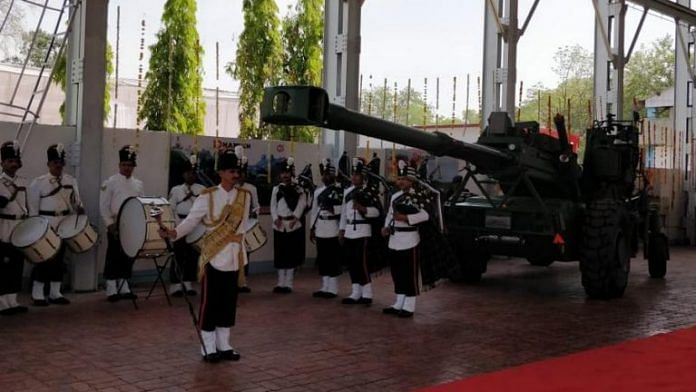New Delhi: The much anticipated large-scale induction of the Dhanush artillery guns, also known as ‘Desi Bofors’, has been hit due to the Covid-19 pandemic as well as production quality concerns flagged by the Army, ThePrint has learnt.
Since April 2019, when the induction started, only 12 of the indigenously built long-range artillery guns have been delivered. This is far below the 18 guns required to make a full regiment.
Incidentally, the first six guns were delivered in April 2019 itself and more of the 155mm x 45mm Dhanush were to be produced subsequently.
The delay meant that the first regiment of Dhanush, which was to be raised by the end of 2019, had not been completed by then and the date was later pushed to March 2020.
Furthermore, while the Army is satisfied with the guns in terms of fire power and mobility, it has flagged multiple concerns regarding the production quality. Dhanush is being manufactured by the Gun Carriage Factory (CGF) in Madhya Pradesh’s Jabalpur, which comes under the state-run Ordnance Factory Board (OFB).
“The production system has still not stabilised. After integrated firing checks, issues have cropped with regard to the hydraulics, sight and even mounting in some cases,” a source told ThePrint.
Sources further noted that the Army is awaiting the production system to stabilise so that a larger number of guns, which is an advanced variant of the Bofors, can be inducted.
Incidentally, the CBI had registered a case in 2017 against a Delhi-based firm and unidentified officials of the Gun Carriage Factory for China-made parts camouflaged as those ‘Made in Germany’ finding their way to the production line of Dhanush.
Also read: Army gets going on plan to buy over 1,700 ‘future tanks’ that will become its main battle tanks
Covid delayed production too
Another issue that has delayed the production is the Covid-19 pandemic which has halted the work at the factory for quite some time now.
According to sources familiar with the matter, several cases of Covid emerged at the Jabalpur factory.
The national lockdown last year and the pandemic also meant that the supply chain got affected, sources said.
OFB officials told ThePrint that initial manufacturing plans faced certain constraints in the supply chain “which have largely been settled”.
They said that the pandemic had a widespread global impact but the OFB is making “all efforts to ensure timely supplies”.
They added that further production of guns is underway. However, they did not respond to a query on the quality concerns raised by the Army.
Also read: India notifies 2nd list of defence items it won’t import, industry hopes more will be added
Army has ordered 114 Dhanush
Dhanush passed its final test at Pokhran in June 2018, after trials in high altitude areas like Sikkim and Leh and in hot and humid weather in Balasore, Odisha and Babina in Jhansi.
The GCF got the Dhanush project in October 2011 and the first prototype was built in 2014. The Army had ordered 114 Dhanush guns in 2018.
A towed howitzer with a strike range of 38 km, Dhanush has been developed on the basis of the first phase of Transfer of Technology (ToT) deal as part of the Bofors contract in the late 1980s.
However, the Swedish Bofors company (now owned by Britain’s BAE System) could not complete the ToT as the deal got embroiled in a major political row following allegations of kickbacks under the then Rajiv Gandhi government.
The Bofors gun subsequently became the backbone of the Indian Army’s operation in the 1999 Kargil conflict with its pinpoint accuracy in targeting enemy positions.
Costing about Rs 14.5 crore a piece, Dhanush is equipped with an inertial navigation-based sighting system, auto-laying facility, onboard ballistic computation, and an advanced day and night direct firing system.
The self-propulsion unit of the gun allows it to be easily deployed in mountainous terrain.
Also read: DRDO will begin trials of Made-in-India towed artillery in June but Army still has ‘concerns’



